The Gossamer Gear Mariposa 60 is a lightweight ultralight-style backpack that weighs 34.5 oz. It’s ideal for weekend backpacking and long-distance trips, particularly if you prefer a backpack that has lots of pockets and a frame, like a more conventional backpack, but weighs half as much. Sporting a unique combination of pockets, it’s an easy backpack to use because you can pack “like” gear together and find it quickly without having to remove everything in your backpack first.
Specs at a Glance
- Weight: 34.2 oz (size medium, straight hipbelt)
- Gender: Unisex
- Frame: Yes
- Pockets: 7, plus the main compartment
- Load lifters: Yes
- Hydration Ready: Central hose port, no bladder pocket
- Bear Canister Compatible: BV500 fits vertically, BV475 fits horizontally.
- Torso length range (multiple sizes available): 16″-22″
- Hip belt lengths range (multiple sizes available): 26″-61.5″
- Materials: 100d and 200d Robic nylon
- For complete specs and sizing, visit the Gossamer Gear Mariposa 60 product page
What Makes the Mariposa 60 so Unique?
The Gossamer Gear Mariposa 60 has been on the market for over 15 years and has undergone many design changes during its lifetime. While those changes have improved its durability, carrying capacity, and quality, the pack’s personality and widespread popularity have stayed the same. What is it that makes the Mariposa 60 so beloved by the people that use it? I’ve long pondered that question since I bought my first Mariposa 60 back in 2008 to hike Vermont’s Long Trail.
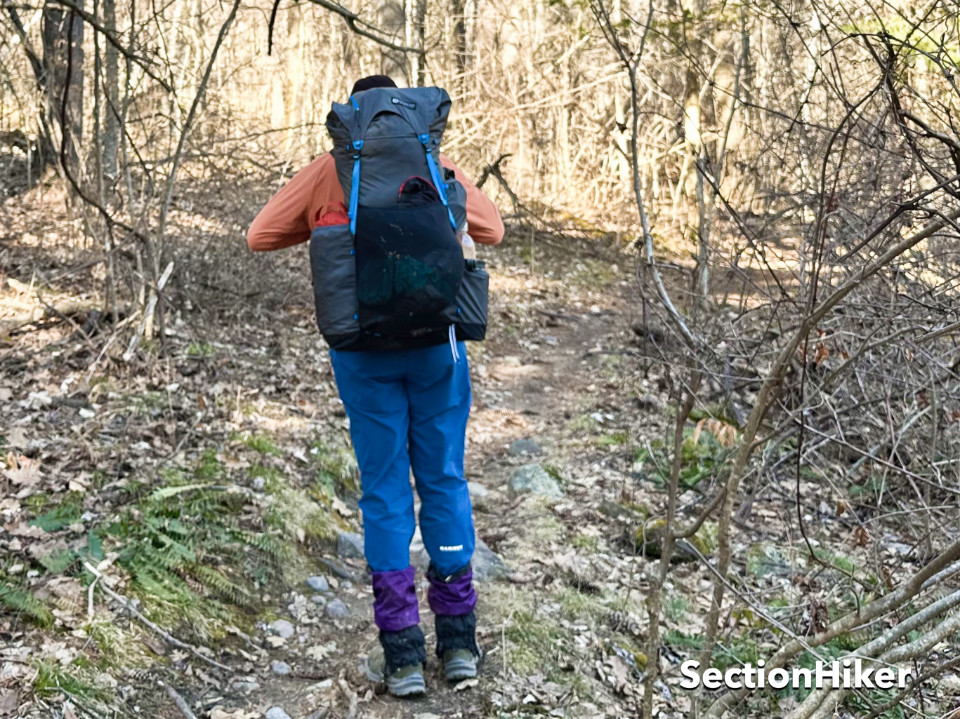
If there’s one thing that’s remained constant during the Mariposa’s evolution, it’s the configuration of its side pockets, with one long tent pocket on the left and two smaller pockets on the right side of the pack. This pocket layout lets you move some of the bulky gear that usually hogs up the main compartment, like a tent and or a Jetboil, to an outside pocket, making it much easier to pack the gear that you don’t need during the day and want to keep dry and safe inside the pack.
This pocket layout lets you easily pack your backpacking gear by function, frequency of use, or time of day without resorting to using extra stuff sacks. For example, you might pack your shelter and all of its accessories in an exterior pocket so you don’t have to dig around for them when you get to camp. I do this myself, packing my tent and stakes in my Mariposa’s long left pocket so I can get to them out quicky. You can do a similar thing with your “kitchen”, “rain gear”, or “water filter/purification”.
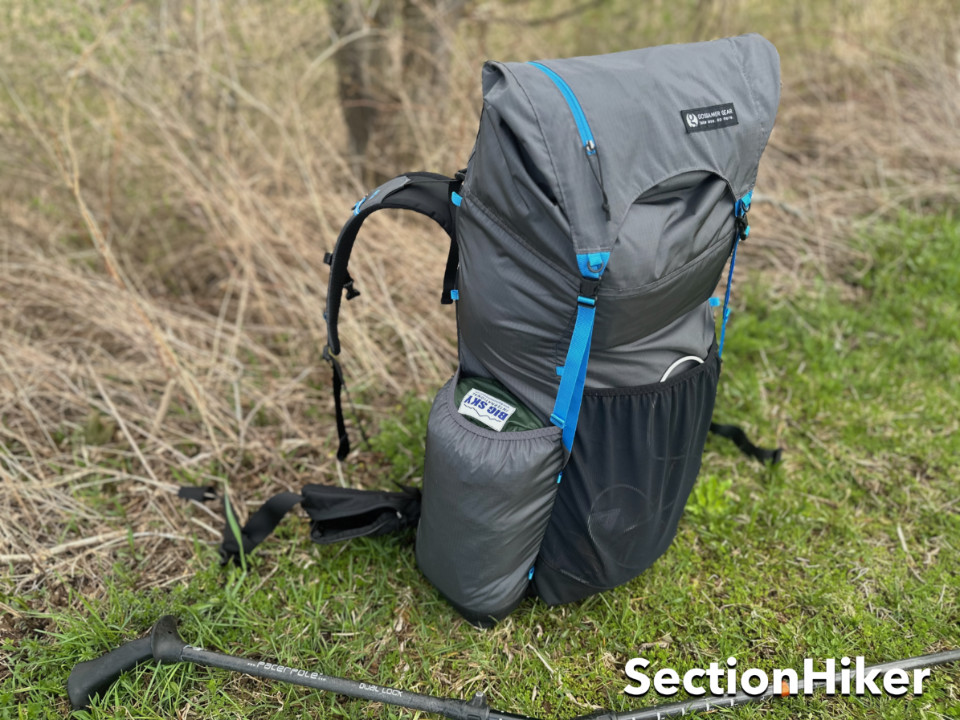
But the Mariposa isn’t for everyone. For all of their benefits, the pack’s external pockets can be difficult to adjust to if you don’t carry a tent or you’ve been weaned on ultralight-style packs that have symmetrical water bottle pockets. They also make it impossible to add functional compression straps to the pack, which can make it awkward to compress less than full loads. You can still attach gear to the outside of the backpack, but the compression capability is lacking.
What’s new in this latest version of the Mariposa 60? The pack weighs about 4 oz more, up from 30 oz, and is now priced over $300. There’s an entirely new frame that pivots as you walk. There are two new hip belt options and the shoulder straps are S-shaped to fit men and women. The available torso lengths have changed. There are new trekking pole holders on the front of the pack and the pack is now made with recycled Robic fabric.
Backpack Organization and Storage
The Mariposa 60 has seven external pockets and a main storage compartment.
- Front stretch mesh pocket
- Left-hand tent pocket
- Upper right accessory pocket
- Lower right water bottle pocket
- Over-the-top map pocket
- Two hip belt pockets
There isn’t an internal hydration pocket, just a loop that you can hang a bladder from.
Front Stretch Mesh Pocket
The front stretch mesh pocket is a good place to store wet items and extra layers you want easy access to during the day so you don’t have to stop and open the main compartment. The mesh weave is open so it drains well and it’s gotten much tougher over the years, so it has good durability. The base of the mesh pocket is reinforced with 200D Robic nylon like the rest of the pack bottom so it won’t rip or abrade when you set it on the ground. There’s also a drain hole at the base so the pocket won’t collect water in the rain.
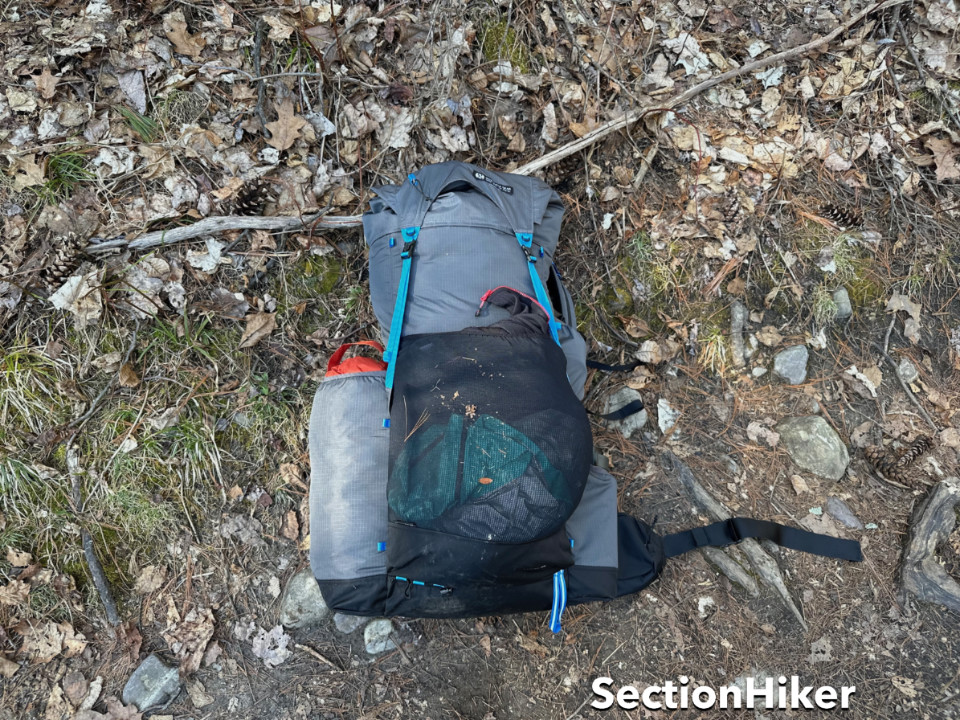
The Tent Pocket
The left side of the Mariposa has a long tent pocket (I like to call it a “quiver”), 13 inches deep and open at the top, which is ideal if you carry a one or two-person tent. In addition to a tent, you can put anything you want into this long pocket, like a hammock/tarp or larger items that you want to segregate from the rest of your gear. For example, if your tent gets wet at night, or soaked with internal condensation, this tent pocket is a good place to store it separate from your other dry gear. It also makes it convenient to pull out to dry in the sun if you stop for a rest break.
The tent pocket also works well with tents that have components that make them hard to pack sideways in the main compartment, like the tents with longer tent poles. However, the contents of the tent pocket cannot be reached when you’re wearing the backpack, so it’s not a particularly good place to put a water bottle unless it’s being held in reserve.

Right-hand Accessory and Water Bottle Pockets
The Mariposa has two right-hand pockets, one on top and one on the bottom. They’re both 8″ tall and open on top with an elastic band to keep their contents from popping out. The bottom pocket is designed specifically to hold two, one-liter water bottles, including 32 oz Nalgenes or Smartwater bottles. Water bottles stored there are easy to reach and replace while wearing the backpack. I often carry my cook system in the upper right-hand pocket, especially if it’s wet.

Map Pocket
There’s a map pocket in the fold-over lid that’s also handy for storing your personal effects. It extends the width of the fold-over lid, so it’s quite large, but whatever you put inside it has to be flexible to wrap over the top of the main compartment.
Hip belt pockets
The hip belt comes with two large zippered pockets that are solid-faced for durability and water resistance. I usually use these to store my compass and a folded-up map, Aquamira water treatment drops, or bug dope, but they’re also large enough to store a smartphone or a point-and-shoot camera.

Main Compartment
The main compartment is cavernous and unstructured. I usually line the Mariposa with a white plastic compactor trash bag to help protect my gear from moisture even though the Mariposa’s Robic nylon fabric is quite water-resistant. A white compactor bag also makes it easier to find gear inside the pack.
There is a hang loop in the main compartment, where you can suspend a water reservoir if you choose to use one. The hydration port is centered between the shoulder straps and covered to prevent rain from leaking in. Using a hydration system is not a bad way to carry water in a Mariposa because it can be tricky to balance the load across the right-hand water bottle pocket and the left-side tent pocket. Alternatively, you can carry your water by attaching Gossamer Gear’s water bottle sleeves to your shoulder straps.
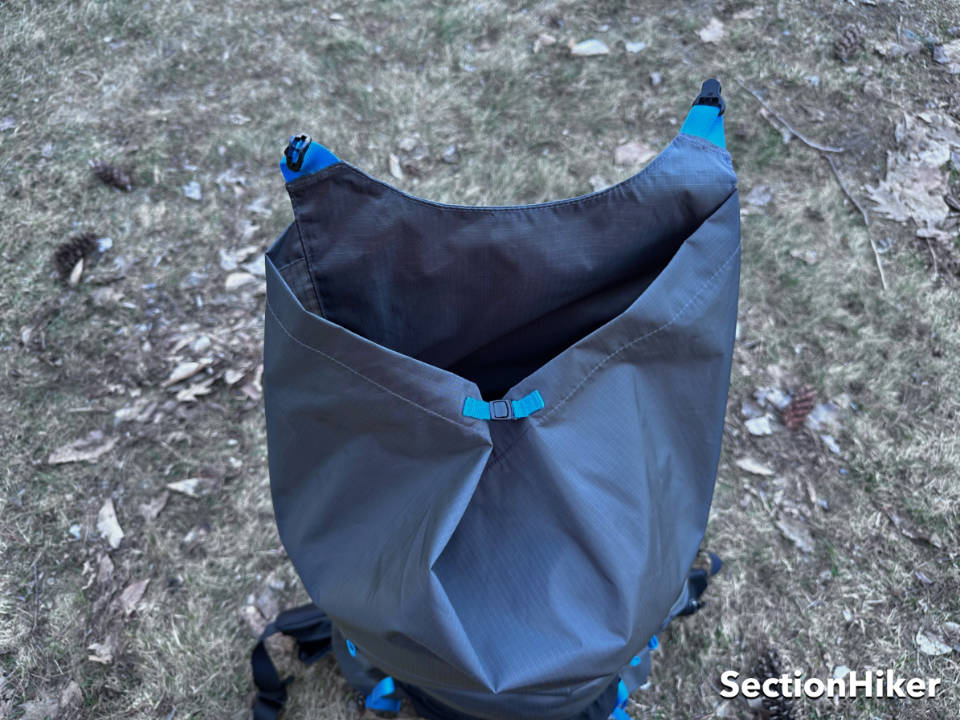
But the closure at the top of the main compartment is a bit clunky, particularly if you lack manual dexterity (think arthritis). There is a small plastic clip used to cinch close the top of the extension collar before you can fold the over-the-top flap over it. It’s a little awkward, but you shouldn’t have to use it very often during the day if you pack all the food and gear you need in the pockets on the outside of the backpack. Rolltop closures can be similarly annoying, but then again, not if you pack the gear you need during the day in the exterior pockets of the pack.
Backpack Frame and Suspension
While the Mariposa 60 looks the same as the previous model, the frame and suspension system were completely replaced in this latest model to provide more inclusive sizing for men and women. In the past, Gossamer Gear was very “unisex” in its orientation, but as the market for ultralight backpacks has grown, it became clear that women (and people with small statures) wanted breast-friendly S-shaped shoulder straps and pre-curved female-friendly hip belts.

Since S-shaped shoulder straps are comfortable for both men and women, they’re now standard on the Mariposa 60. There are also two new PVT (stands for Pivot) hipbelt options available for the Mariposa: a Straight hipbelt similar in fit to the unisex hipbelt sold on earlier models and one with curved wings designed for people (mostly women) with curvier hips and smaller waists. See Gossamer Gear for fitting instructions (scroll down the page).
The new PVT hip belts are not compatible with older model Mariposa backpacks, so you’ll need to buy an entirely new backpack if you want to take advantage of the new design. Gossamer Gear changed how the frame connects the hipbelt, making it much simpler to swap than previously. The bottom of the frame is curved and slots into a pouch-like cup at the back of the hipbelt with the added benefit that the sides of the hipbelt can Pivot, that is, move slightly up or down with your hips as you walk. Other backpack makers Gregory, Deuter, and Osprey have hipbelt systems that offer a similar pivot benefit but are much heavier in their implementation.
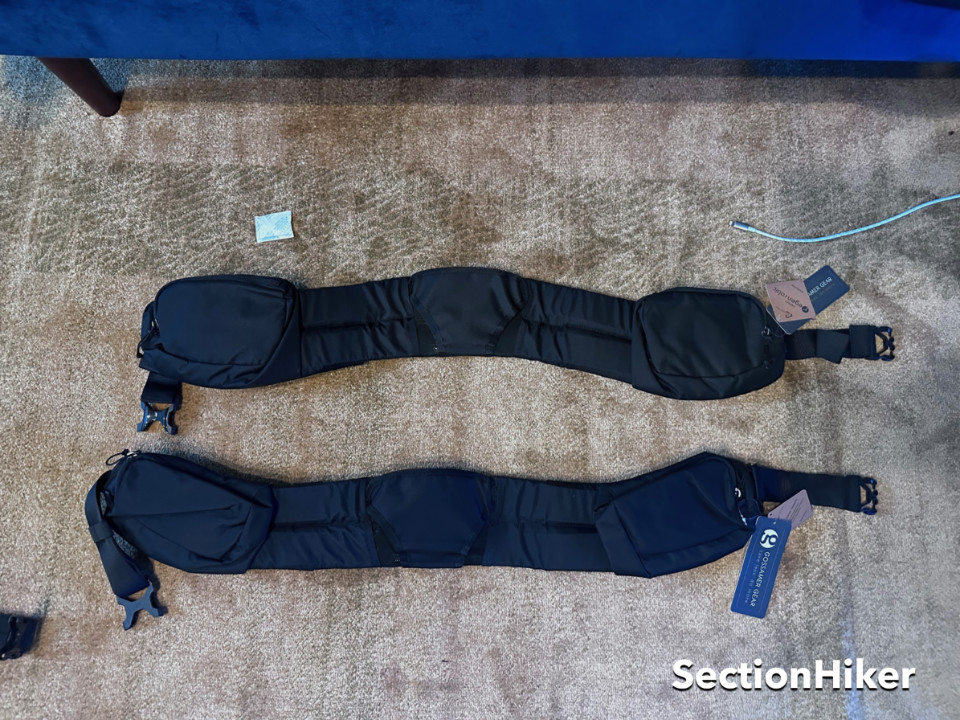
A bigger benefit of the new Pivot system is that it’s much easier to swap in a new PVT hipbelt if you want to replace the one that comes bundled with the Mariposa. Gossamer Gear sells three out-of-the-box configurations of the Mariposa with preconfigured hip belts and five different hipbelt sizes, which cost an additional $25 if you want to customize your fit. Gossamer Gear will refund the $25 if you send back the original hipbelt – contact them for details.
The PVT frame is also a 360 loop instead of the 270 degree U-shaped frame used in previous models, making for a much stiffer and more responsive carry. Gossamer Gear also added more stiffeners to the back of the hipbelt, resulting in better load transfer to the hips.

In addition, there is a new foam sit pad included that slots into mesh sleeves behind the shoulder straps. While it has holes in it, they don’t provide any ventilation to dry perspiration in your shirt. Still, the sit pad is very handy to pull out when you want a dry spot to sit down in camp or a porch in front of your tent, and easy to slot back into the mesh sleeves when you’re ready to take off again. While you can replace the foam pad with another of your choosing, you want to avoid using something like a full Zlite foam pad because it will be too thick and position the pack too far away from your torso.
The Mariposa includes load lifters which I consider important on higher volume backpacks, starting at about 50 liters of capacity. Without load lifters, a heavily loaded backpack can have the tendency to pull you backward and off-balance. Load lifters help counter the backward tilt of a heavy pack, bringing it closer to your back, and shifting more of the weight onto your hips.
External Attachment and Compression System
The Mariposa 60 is noticeably light on side compression straps and external attachment points because the side pockets get in the way of having them. However, there are tiny webbing loops purposely distributed around the perimeter of the pack that let you create your own compression or attachment points with some cord and a cord lock. Gossamer Gear sells a convenient accessory cord kit for just this purpose.

There are 8 x 2 such webbing loops sewn into the seams of each side of the backpack and plastic rings on and above the shoulder straps that are good anchors for the accessory pockets that Gossamer Gear sells. You can so route accessory cord through those webbing loops and plastic loops in many different ways. For example, you can rig up:
- Rig up a pair of parallel cords on each side to carry snowshoes or a foam pad.
- Crisscross a cord over the front mesh pocket to dry wet clothing.
- Secure a solar panel so it drapes down the front of the pack.
The possibilities are really endless and help overcome the fact that the side pockets make it hard to provide two tiers of webbing-based side compression straps.
With a little imagination, you can use also the top fold-over pocket to sandwich awkwardly shaped gear like a foam sleeping pad or cylindrical tent body onto the top of the main compartment, making it easier and more convenient to carry. (In the past, I was able to fit a small bear canister under the over-the-top lid pocket, but not on this latest model. YMMV)
The Mariposa has the requisite ice ax loop as well as trekking pole tip holders found on most packs but does not include shaft holders for either making them a bit hard to use unless you have some of that cordage around.

Comparable Internal Frame Backpacks
Recommendation
The Gossamer Gear Mariposa 60 Backpack is perfect for hikers transitioning from a heavier backpack to a lighter-weight one because it provides plenty of storage and pockets to organize your gear. It has a lightweight frame that provides plenty of load-carrying support for heavier loads. With a maximum recommended load of 30-35 pounds, you’ll be hard-pressed to find a backpack that’s as comfortable, refined, and easy to use as the Mariposa 60.
If you don’t need 60L of capacity, but like what you see in the Mariposa, check out the 50L Gossamer Gear Gorilla. It has fewer external pockets than the Mariposa but is also a great backpack.
Disclosure: Gossamer Gear donated a backpack for review.
SectionHiker is reader-supported. We only make money if you purchase a product through our affiliate links. Help us continue to test and write unsponsored and independent gear reviews, beginner FAQs, and free hiking guides.
